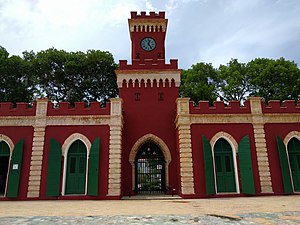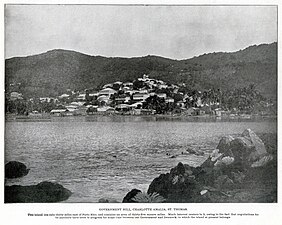Charlotte Amalie, U.S. Virgin Islands
Charlotte Amalie (/ˈʃɑːrlət əˈmɑːli(ə)/ SHAR-lət ə-MAH-lee(-ə)),[2] located on St. Thomas, is the capital and the largest city of the United States Virgin Islands. It was founded in 1666 as Taphus (meaning 'tap house' or 'beer hall' in Danish).[3] In 1691, the town was renamed to Charlotte Amalie after the Danish queen Charlotte Amalie of Hesse-Kassel (1650–1714). It has a deep-water harbor that was once a haven for pirates and is now one of the busiest ports of call for cruise ships in the Caribbean, with about 1.5 million-plus cruise ship passengers landing there annually. Protected by Hassel Island, the harbor has docking and fueling facilities, machine shops, and shipyards and was a U.S. submarine base until 1966. The Town has been inhabited for centuries. When Christopher Columbus arrived in 1493, the area was inhabited by Caribs, Arawaks, Ciboney and Taíno native peoples. It is on the southern shore at the head of Saint Thomas Harbor. In 2010 the City had a population of 18,481,[4][5] which makes it the largest city in the Virgin Islands Archipelago. Hundreds of ferries and yachts pass by the Town each week.
Charlotte Amalie
The City is known for its Danish colonial architecture, building structure and history. Dozens of streets and places throughout the City have Danish names. Charlotte Amalie has buildings of historical importance including St. Thomas Synagogue, the second oldest synagogue in the United States,[6] and Frederick Lutheran Church. The Town has a long history of pirates, especially myths of Bluebeard, and facts and stories of Blackbeard (Edward Teach). In the 17th century, the Danes built both Blackbeard's Castle and Bluebeard's Castle attributed to the pirates. Blackbeard's Castle is a U.S. National Historic Landmark. Another tourist attraction is Fort Christian, the oldest standing structure in the Virgin Islands Archipelago. A copy of the Liberty Bell and freed slave blowing a conch shell are in Emancipation Park, which is both a source of national pride and a tourist attraction.[7]
Like the rest of the U.S. Virgin Islands, Charlotte Amalie has no local government and is directly administered by the territorial government. However, it has boundaries defined by the Virgin Islands Code and is recognized as a town by the U.S. Census Bureau.[8]
Population[edit]
Demographics[edit]
The 2010 United States Census reported that Charlotte Amalie had a population of 18,481.
A 76.2% majority are Afro-Caribbean, while a minority of 13.1% are white. About one percent is of Asian descent.[20]
Religion[edit]
According to the CIA World Factbook, more than 95 percent of the people describe themselves as Christians. 42% are Baptist, 34% Catholic and 17% Episcopalian.[20] There are also Jewish, Hindu and Muslim populations of European, Middle Eastern and Caribbean origin.
The city's Saints Peter and Paul Cathedral is the episcopal see of the Roman Catholic Diocese of Saint Thomas, which covers the American Virgin Islands and is the sole suffragan of the Metropolitan Archdiocese of Washington (D.C.).
Saint Thomas is home to one of the oldest Jewish communities in the Western Hemisphere as Sephardic Jews began to settle the island in the 18th century as traders and merchants. The St. Thomas Synagogue in Charlotte Amalie is the second oldest synagogue in the United States.[21]
Languages and literacy[edit]
More than 95 percent of the population are literate.[22]
Although English is the official language, most people speak a dialect called Virgin Islands Creole, which differs from standard English in many ways. Virgin Islands Creole is used informally and standard United States English (spoken with a uniquely Virgin Islands accent) is usually preferred in school, at work and in more formal conversations. Most older children and adults can quickly switch between Virgin Islands Creole and United States English. Spanish is spoken by 16.8% and French Patois is spoken by 6.6% of the city's population.[23][24] While Spanish is spoken by migrants from Puerto Rico (US) and immigrants from the Dominican Republic, creoles are spoken by immigrants from St. Barthelemy, Dominica and Haiti; Dutch and Papiamento are spoken by immigrants from Saba, Aruba, St. Maarten and Curacao.
Education[edit]
St. Thomas-St. John School District serves the community. Addelita Cancryn Junior High School[32] and Charlotte Amalie High School serve the area. The University of the Virgin Islands, located in Charlotte Amalie, was founded in 1962.









